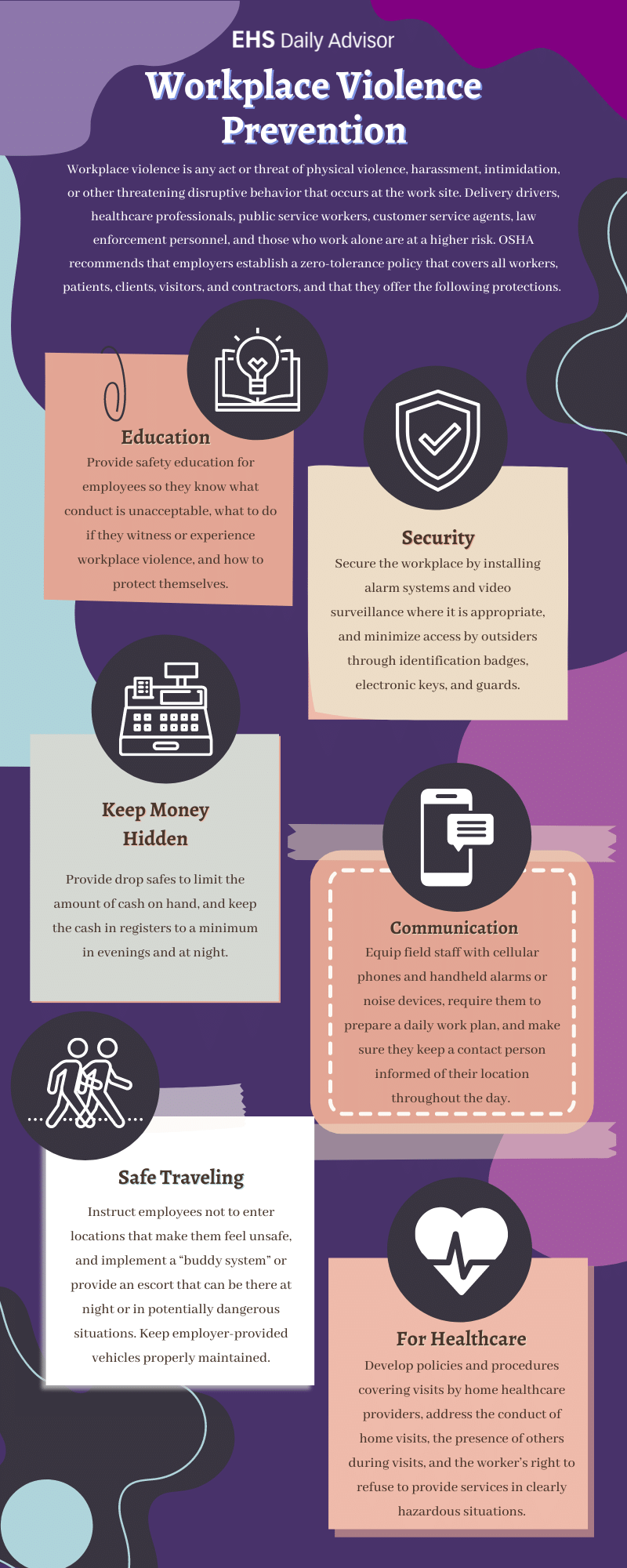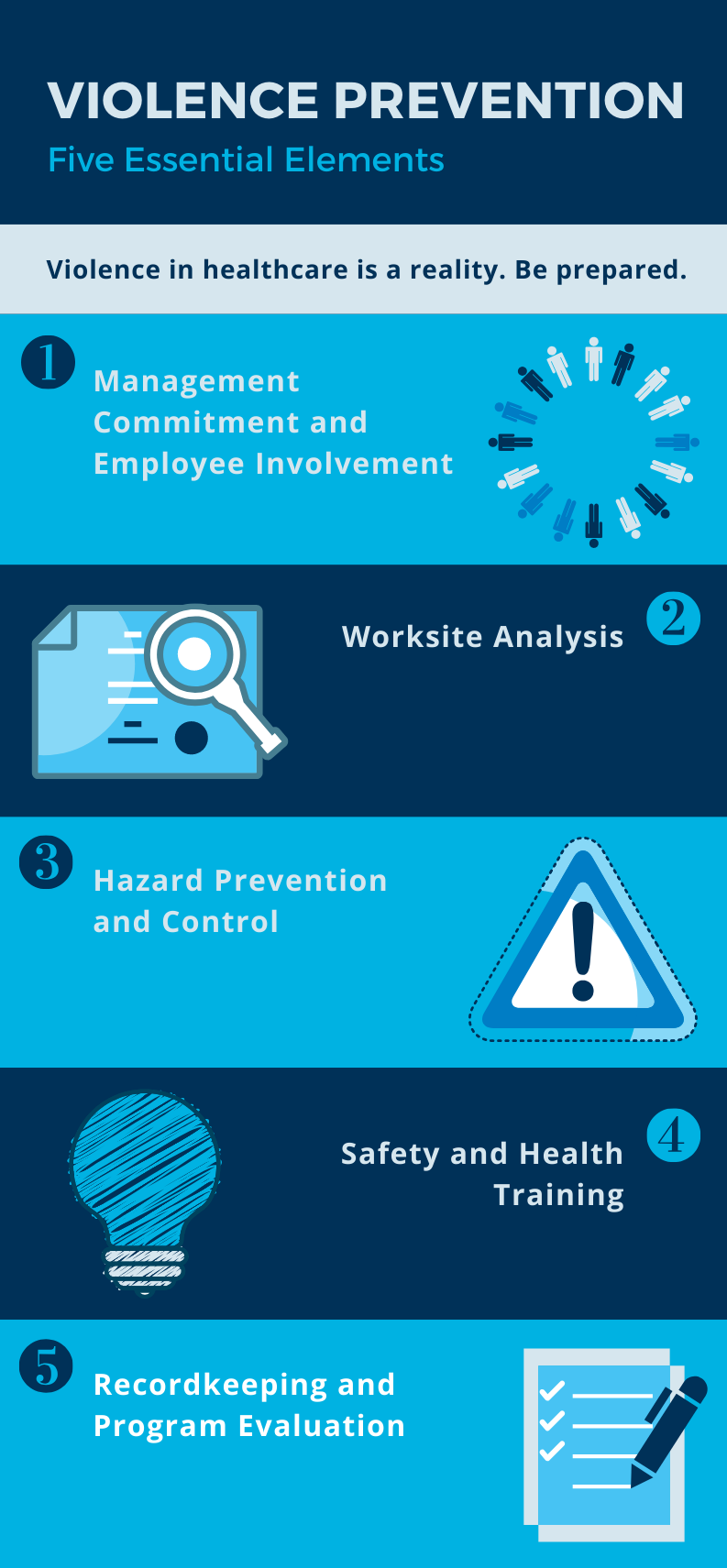Checking Out Efficient Methods and Methods for Implementing Work Environment Physical Violence Avoidance Programs in Organizations
Office violence remains an important concern for organizations, necessitating the execution of robust prevention programs. Comprehending the dynamics of work environment violence and the components that add to effective prevention is important for cultivating a safe atmosphere. This entails not only the facility of clear policies but additionally ingenious training techniques and reliable reporting devices. As companies strive to cultivate a culture of safety, the question emerges: what certain methods can be employed to guarantee these programs are both efficient and sustainable? Discovering this further reveals understandings that might considerably impact workplace safety and security and employee health.
Recognizing Workplace Violence
Recognizing workplace physical violence is essential for cultivating a risk-free and productive atmosphere. Workplace violence encompasses a variety of behaviors that can take place in different types, including physical assaults, hazards, verbal misuse, and also harassment. Such events can emerge from interpersonal problems, occupational stress factors, or outside factors and can significantly interrupt business procedures.
The implications of workplace violence extend beyond prompt physical injury; they can also lead to psychological injury for targets, reduced worker morale, and enhanced absenteeism. Furthermore, companies might deal with lawful obligations and reputational damages as a result of fierce incidents. Identifying the various kinds of office violence is important in order to successfully attend to and mitigate the threats connected with these behaviors.
Efficient management of work environment violence starts with recognizing its underlying causes. Elements such as inadequate communication, lack of support, and poor dispute resolution methods can add to a hostile workplace. By promoting a society of respect, open communication, and aggressive problem management, organizations can lower the likelihood of fierce cases and boost overall office safety and security. Eventually, a comprehensive understanding of work environment violence is a fundamental action towards creating a safe and durable organizational society.
Trick Elements of Prevention Programs
An effective work environment physical violence prevention program is improved several vital parts that collectively create a much safer setting for staff members. A extensive and clear policy laying out the organization's dedication to preventing work environment violence is essential. This plan should specify what constitutes work environment physical violence and the consequences for violations.
Second, danger evaluations should be on a regular basis carried out to determine potential dangers and susceptabilities within the office (california workplace violence prevention). Comprehending the certain risks connected with a company's atmosphere enables tailored interventions
Third, occurrence reporting mechanisms have to be developed to motivate employees to report any kind of issues or events without worry of revenge. This openness fosters a society of safety and security and accountability.

Lastly, leadership commitment is vital; administration must proactively sustain and take part in avoidance efforts. Their participation sets a tone of severity relating to the problem and motivates a collective technique to security.
Training and Education Methods
Executing reliable training and education and learning techniques is essential for gearing up employees with the understanding and abilities necessary to recognize, prevent, and react to workplace violence. Comprehensive training programs ought to be customized to the specific demands of the organization and its labor force, taking into account the distinct dangers related to various job environments.
Educating should encompass various topics, consisting of the recognition of warning indications, de-escalation strategies, and the importance of fostering an encouraging workplace culture. Engaging techniques such as interactive workshops, role-playing situations, and instance research studies can improve finding out retention and encourage proactive engagement among employees.
Furthermore, ongoing education and learning is essential. Frequently scheduled correspondence course make sure that workers remain notified concerning the latest ideal methods and behavior trends associated with workplace physical violence. Integrating comments mechanisms, such as studies or emphasis groups, can help organizations examine the performance of their training efforts and make needed changes.
Reporting and Action Mechanisms
Reliable coverage and action devices are essential for addressing events of office violence quickly and successfully. Organizations must establish clear methods that encourage employees to report cases without fear of retaliation. These systems ought to include multiple reporting channels, such as anonymous hotlines, e-mail, and in-person coverage alternatives, ensuring that all workers really feel risk-free and sustained when revealing events.
Additionally, it is necessary to educate employees on just how to use these reporting systems successfully. Training must highlight the importance of timely reporting, as very early treatment can prevent rise and advertise a more secure workplace. Upon getting a report, companies must have a structured action strategy that includes prompt analysis of the situation, support for damaged individuals, and involvement with police if necessary.
Furthermore, companies need to guarantee that examinations are carried out promptly and completely, sticking to legal and ethical criteria. Openness in the reaction process can build trust among workers and article source demonstrate the company's commitment to safety and security - california workplace violence prevention. Regular evaluations of the reporting and feedback mechanisms will certainly aid identify areas for enhancement, eventually enhancing the general efficiency of workplace physical violence prevention programs
Examining Program Effectiveness
Assessing the performance of office physical violence avoidance programs is important for guaranteeing they meet their intended goals and adjust to the evolving requirements of the company. This procedure includes a systematic analysis of both qualitative and quantitative information to establish program effect, worker assumptions, and overall office safety and security.
Trick metrics for examination might include occurrence rates of work environment violence before and after program application, employee comments with studies, and the utilization prices of reporting devices. Consistently arranged assessments allow companies to identify gaps in their programs and address any type of arising threats quickly.

It is essential to establish clear criteria and goals prior to program implementation, which will facilitate a much more reliable analysis process. By constantly keeping an eye on and refining prevention strategies, organizations can develop a safer job atmosphere and substantially minimize the threat of work environment physical violence. Eventually, reliable analysis ensures that avoidance programs continue to be dynamic and responsive to the demands of the workforce.
Conclusion
In final thought, the implementation of reliable office violence avoidance programs demands a comprehensive technique that includes clear policies, regular risk analyses, and durable training. Engaging educational strategies and accessible coverage mechanisms boost staff member participation and responsiveness. Management dedication plays a crucial duty in growing an encouraging organizational society. Continuous examination via comments and incident metrics guarantees ongoing refinement and renovation of these programs, eventually adding to a safer and more resistant work setting.

In conclusion, the application of reliable workplace violence prevention programs necessitates a comprehensive method that includes clear policies, routine risk analyses, and durable training.